Peperomia is a diverse group of plants that look fussy, but are actually pretty darn easy to care for. In this post, I’ll tell you all you need to know in order grow the healthiest peperomias around.
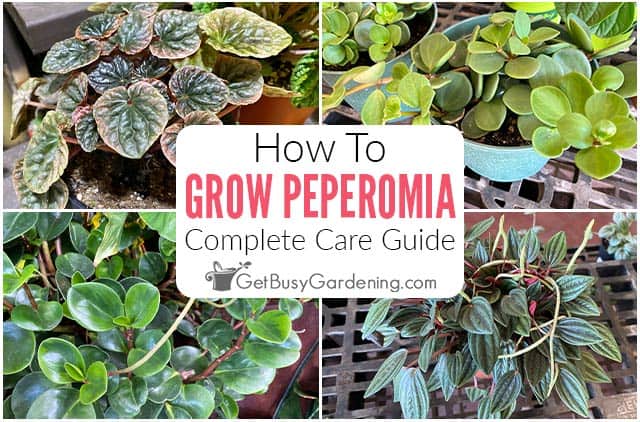
If you’re looking to add diversity to your home or garden, you’ll definitely want to check out peperomias. They are a popular houseplant with many unique foliage options.
No matter which one you have, learning about peperomia care is the first step in keeping your plants healthy for many years.
In this complete guide, I’ll show you everything you need to know about how to grow peperomias. Get my best tips on watering, soil, sunlight, propagation, pest control, and more, all in one handy place.
Information About Peperomias
Peperomia is an incredibly diverse species of evergreen tropical plants that are native to Central and South America. They earned their common name, the radiator plant, thanks to their general love of warm air and sunlight.
There are over 1000 types to choose from. They can look so different, you’d probably have trouble believing all of them are even related!
The good news is, despite the range of options, most are undemanding, and require similar care to thrive.
Different Peperomia Types
With so many varieties out there, you could easily fill your home with tons of colors, shapes, and sizes of peperomia alone!
Here are just a few of the most popular ones:
- Peperomia obtusifolia “Baby Rubber Plant” – This is the most common variety, and very similar in appearance to the popular Ficus elastica. Its waxy, shiny, green oval leaves grow from thick stems.
- Peperomia caperata “Rosso” – The corrugated spade-shaped leaves are green on top and a striking red beneath, and form in compact rosettes on red stems.
- Peperomia agreyeia “Watermelon” – Has wide rounded spade-like leaves that are colored just like a watermelon rind, and grow from deep red stems.
- Peperomia caperata “Frost” – The deeply ridged leaves on this species look like they’re dusted in silvery white snow with darker green veins.
- Peperomia ferreyrae “Green Bean Plant” – This compact specimen has thin, bright green, bean-shaped leaves in upright clusters.
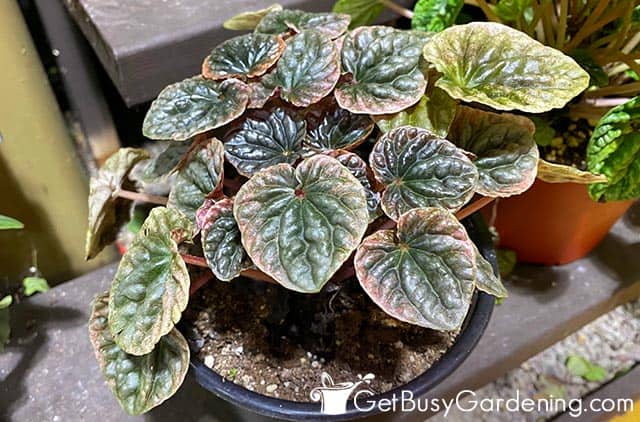
Flowers
While they can flower, some more often than others, it’s rare on indoor plants. But to a beginner, the bloom spikes may not look like flowers at all.
They are unscented, can be cream or white, and look like long, thin tubes instead of more traditional blossoms. Flowers generally appear sometime in the summer.
The unremarkable appearance is usually second to the striking foliage peperomias are grown for.
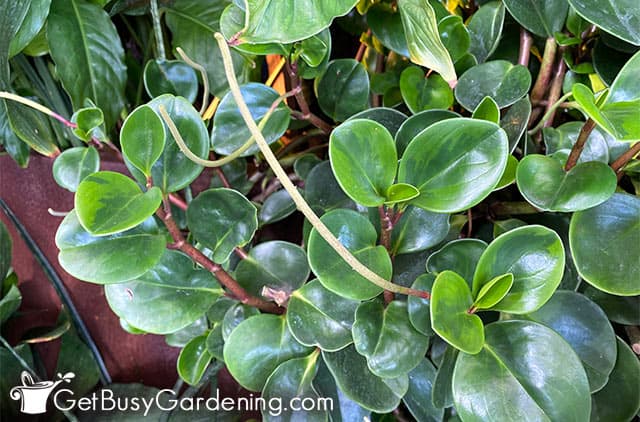
How To Grow Peperomia
Before we dive into the details of peperomia plant care, first we should talk about where to grow them. Choosing the right location can help yours thrive for decades.
Hardiness
One thing they all share is a love of warmth. They’re hardy only in zones 10+, and do not tolerate temperatures lower than 50°F for very long.
Chilly temps will quickly damage the leaves. Prolonged cold exposure can cause leaf drop, and will eventually kill the plant.
In many areas, they’re kept exclusively as houseplants. But, when it’s warm enough, you can move yours outside so it can enjoy the summer weather.
Where To Grow Peperomia
If you live in a warm climate, you can grow peperomia outdoors in either pots or the garden. Place them in an area that is shaded from the afternoon sun.
As indoor plants, they love bright light in either east or west facing windows, but can scorch in direct sunlight.
Some have trailing vines making them ideal for hanging baskets, while others are compact.
Either way, choose a container with good drainage to help prevent issues like overwatering and root rot.
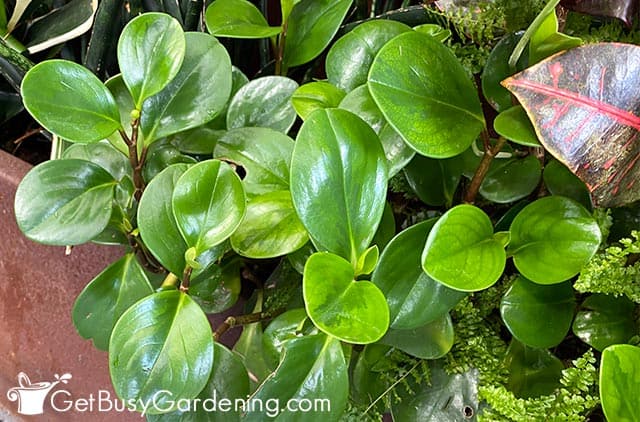
Peperomia Plant Care & Growing Instructions
Now that you’ve got the ideal location in mind to grow them, it’s time to talk about the details of peperomia care. Follow these tips for the best success.
Light
Most peperomia species prefer medium to bright light, especially the colorful ones. Some can tolerate direct sun, but many will burn if exposed to the harshest afternoon rays.
Others will tolerate low light, or even fluorescent settings indoors, but it can significantly slow growth and dull the foliage color.
If a bright, indirect, natural light source isn’t available, add a grow light to keep yours from getting leggy.
Water
Most peperomias are very good at retaining water in their leaves and stems, so they don’t require much from us.
A good rule of thumb is to wait until the top 2” of soil is dry to the touch before giving them a deep drink. Always drain off the excess from the tray beneath, and never leave them sitting in water.
Root rot from overwatering is a common reason for poor health with these plants. I recommend investing in a moisture gauge if this is something you struggle with.

Humidity
Some peperomias thrive in high humidity, but most are tolerant of moderate levels, especially indoors.
If it’s extremely dry in your home, you can provide extra by misting them occasionally, setting up a humidifier nearby, or placing them on a pebble tray filled with water.
Temperature
Since they are sensitive to the cold, be sure to grow your peperomia in a warm environment where it stays between 65-85°F.
You can put them outside in spring to enjoy the summer weather. But move them back inside before it drops below 50°F, to avoid damage.
Fertilizer
Fertilizing peperomia is not a necessary part of their regular care routine. But like all plants, the occasional feeding can stimulate more robust growth, vibrant colors, and also encourage flowers.
A good choice is a natural houseplant food or a compost tea that you can apply once a month in the spring and summer. Stop fertilizing completely in the fall and winter.
If yours is enjoying some outdoor time, you can also top-dress them with worm castings, or apply slow-release granules. But I recommend avoiding any chemical products, as they can burn and damage the leaves.
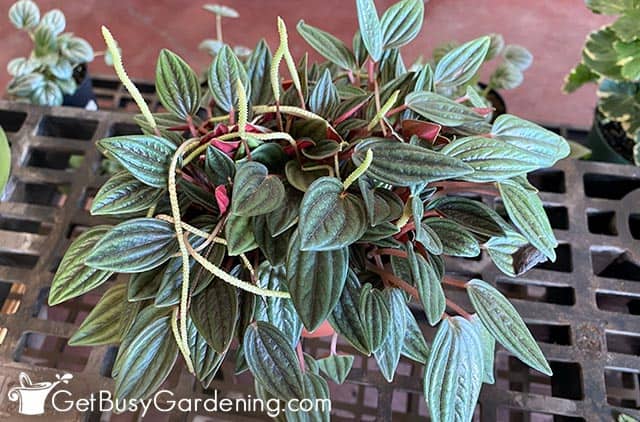
Soil
Some peperomias are actually epiphytic, which means they grow natively on rocks or trees, and absorb nutrients through the air. While those don’t necessarily need soil, all types do great in containers.
They aren’t particular about acidity, but they do prefer a rich mixture that’s very loose to promote good drainage.
A general purpose mix, or one that is more porous, are both great options to purchase. Or you can mix extra perlite to make it drain faster.
Repotting
Most peperomias are fairly slow-growing and prefer to be a little pot-bound, so they don’t require repotting as part of their regular care routine.
Wait until you see roots peeking out from the drainage holes on the bottom to change containers.
It’s best to tackle this in the spring or summer. Bury them at the same depth in a container just 1-2” larger than their current one.
If it has been a few years and yours isn’t showing signs of needing a new pot, adding slow-release fertilizer can help restore nutrients to the soil.
Pruning
There’s usually no need to prune peperomias as part of your regular care routine, especially if they grow fairly compact.
But you can trim them back to maintain vine length, or if they start becoming leggy and sparse.
If they have long, wild stems, cutting them back in the spring will help encourage a more compact and fuller shape.
Use sharp, sterile pruning snips to cut the stems down to a manageable size. You can also pinch or clip off any discolored or damaged leaves as needed.
Pest Control Tips
Healthy peperomia plants rarely have issues with pests, especially indoors. But from time to time common ones like mealybugs and spider mites can pop up.
Use natural treatment options, like neem oil or insecticidal soap to manage a current infestation and deter future problems.
To make your own natural insecticidal spray, simply mix 1 teaspoon of mild liquid soap with 1 liter of water, and apply it to the entire plant.
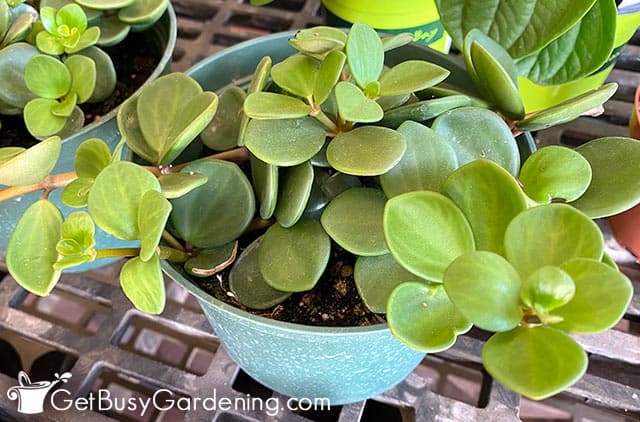
Peperomia Propagation Tips
While they can actually be propagated at any time of year, to increase your odds, I suggest waiting for spring or summer.
The most common method is rooting stem cuttings. Simply clip off a healthy piece of stem or vine, dip it in rooting hormone, and plant it in lightly moistened, well draining soil.
Keep it in a bright location either in a propagation chamber, or covered with plastic to provide humidity. Get the full step by step instructions here.
Troubleshooting Common Peperomia Problems
Most peperomia plants are pretty easy to care for, and very undemanding of our time and attention. But over the years you may experience one of these common issues. Here are my tips for getting yours healthy again.
Leaves Turning Brown
Peperomia leaves can turn brown due to incorrect watering, or too much sun exposure.
Always allow the top few inches to dry out before watering again, and make sure the plant is protected from any direct sunlight.
If the leaves are brown and crisp, you may need to water more often, or increase the humidity level. Try to avoid letting them be bone dry for long periods.
Peperomia Leaves Falling Off
Leaf drop on peperomias can be caused by improper watering, but also lack of light, or exposure to cold temperatures.
If you aren’t over or underwatering, move it to a brighter location or add a grow light. Also, make sure the temperature stays above 65°F.
Yellow Leaves
Yellow leaves are most commonly caused by overwatering. Peperomias are susceptible to root rot if they stay wet for too long.
So wait for the soil to dry out, and then give them enough water to moisten it. Make sure the pot has adequate drainage holes, and never let them sit in water.
Leaves Turning Black
If yours is experiencing black leaves, then it’s probably an issue of cold exposure or overwatering. Double check that the soil is not soggy or retaining too much moisture.
Move them indoors before it gets below 50°F, and keep them away from chilly windows or areas that experience cold drafts. A space heater can be helpful if you have them in a cooler room.
Exposure to frost outdoors, or even just contact with a freezing window indoors can also cause blackening of the leaves.
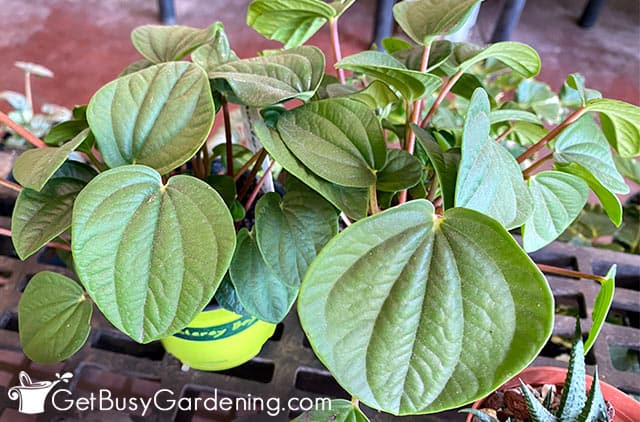
FAQs About Peperomia Care
Here you’ll find answers to some of the most commonly asked questions about peperomia plant care. If yours isn’t here, please add it to the comments section below.
Is peperomia a succulent?
No, a peperomia is not a true succulent. But the ability of the leaves to store water causes many gardeners to refer to them as ‘succulent-like’.
Are peperomias easy to care for?
Yes, peperomias are considered easy to care for because they require infrequent watering, are tolerant of various light levels, and don’t require much maintenance to thrive.

Is peperomia a good indoor plant?
Yes, peperomia is a good indoor plant because it’s low-maintenance and loves the warmer indoor temperatures of most homes.
How often do peperomias need to be watered?
Peperomias don’t need to be watered very often, only when the top two inches of soil have dried out. Rather than watering on a set schedule, always check to make sure it actually needs it first.
Is peperomia safe for cats and dogs?
Yes, peperomia is safe for cats and dogs. They are considered non-toxic according to the ASPCA website.
Whether you just bought your first, or have many peperomias, learning how to give them the best care is very important. The tips I’ve shared in this growing guide will help you keep them healthy and thriving for years.
If you want to learn all there is to know about maintaining healthy indoor plants, then you need my Houseplant Care eBook. It will show you everything you need to know about how to keep every plant in your home thriving. Download your copy now!
More Houseplant Care Guides
- How To Care For String Of Pearls Plant
- How To Care For Goldfish Plant (Nematanthus gregarius)
- How To Care For African Mask Plants
- How To Care For Alocasia Plants
- How To Care For Kalanchoe Plants
- How To Care For Dracaena marginata (Madagascar Dragon Tree)
- How To Care For A Philodendron Birkin Plant
Share your peperomia plant care tips with us in the comments section below.
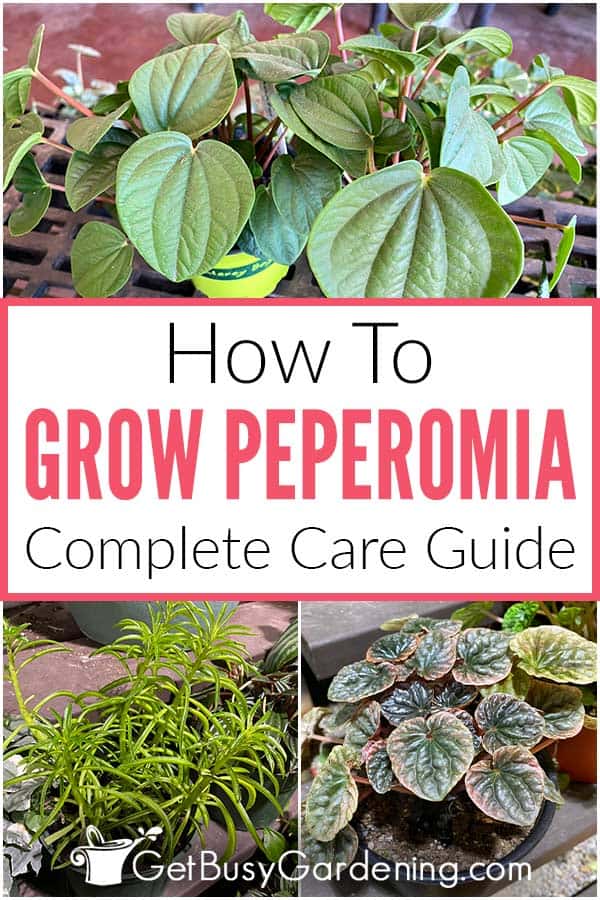
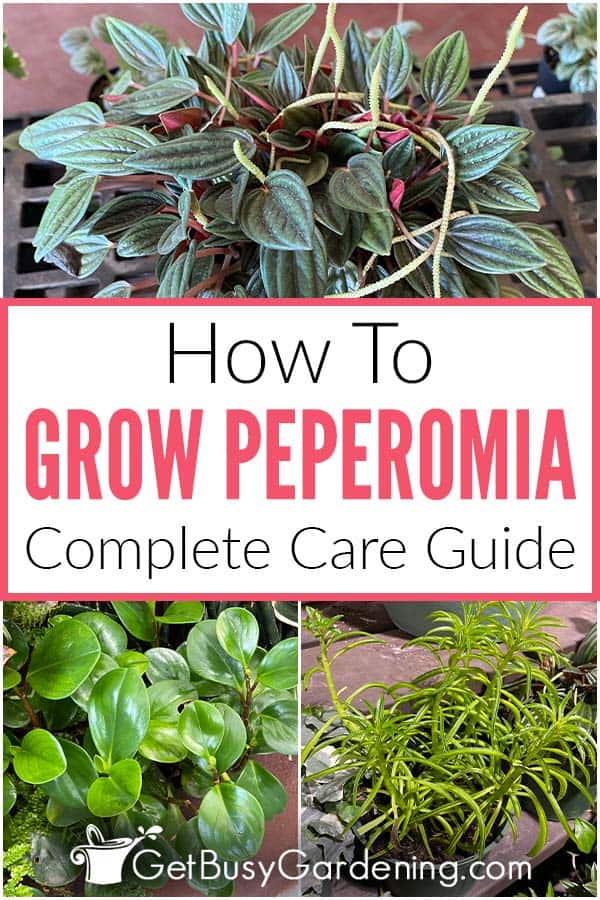
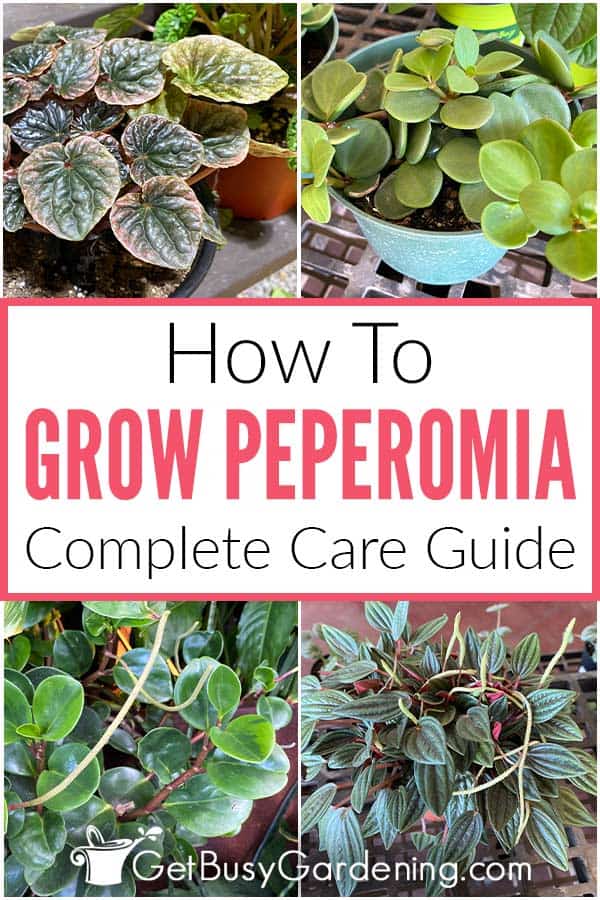



Leave a Reply